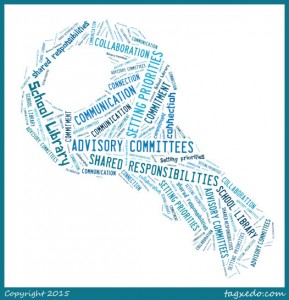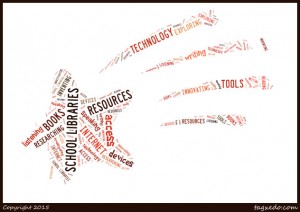Hello BACC readers,
I am writing to you on a cold and rainy day in South Georgia; a day with just enough fog to make my small town look like it belongs in the Chronicles of Narnia. I am also writing to you after having enjoyed listening to my nine year old daughter read sections from Jacqueline Woodson’s Brown Girl Dreaming aloud to me as we snuggled on the coach before school. I share this second tidbit with you because Brown Girl Dreaming is a book leveled above 3rd grade, and one not many third grade teachers would be likely to stock in their classroom collections. Thankfully, my daughter was able to check this book out from her school library under the guidance of a school librarian who is aware of my daughter’s reading capacity and interest.
When thinking on the BACC theme this month (school libraries compared to classroom libraries), several threads began to weave themselves together. I’d like to share those threads with you all.
Thread 1: Is it “And” or “Vs”?
As a school library educator, my job is to prepare future school librarians. It occurred to me that in our program here at Georgia Southern, we do not formally address the presence of classroom libraries. Since the overwhelming majority of our students are classroom teachers, I imagine many of them maintain these collections in their classrooms. Does it behoove the school librarian to push against classroom collections? To discourage their presence and present a negative reaction to their existence? Should I teach my school library candidates to set their cross-hairs for classroom collections, ridding the world of these “imposters?”
I don’t think so.
Much of what we do is inter-relational, and oftentimes, politically sensitive. I cannot see the benefit in attacking an effort that comes from a well-intentioned place, and I actually think this would hurt a librarian’s ability to maintain positive interactions with his or her colleagues.
Thread 2: The Terms We Use
When Judi blogged last week, someone posted that he preferred the term “classroom collections” to “classroom libraries.” I think he makes an excellent point. The terms we use are extremely important. The school library should not merely house a collection of books, e-books, databases etc. Its primary treasure, I argue, is the expertise the school librarian embodies; an expertise that multiplies the impact of those instructional resources. The classroom collection is not a library because it is missing the information literacy expert. Tying thread 2 to thread 1, I think it is our job as school librarians to promote this expertise, to be willing to engage in collaboration and multiply the impact of any library resource – be it space (makerspace activities, after school coding clubs), be it print, be it online research. If a teacher asks for my help, for my expertise, I am going to say yes! I am going to prove that I am the key resource in that school library! Instead of attacking classroom collections, encourage teachers to see the multitude of extras they have access to when accessing the school library (and you!).
Thread 3: Comparing Apples and Oranges
Years ago, I was a music teacher in Fort Worth, Texas. For a while, this school district considered getting rid of elementary music because it was reasoned that classroom teachers could easily sing songs or play music games (hey! We have boom boxes now!) with their own students. The community fought back. Music teachers explained that simply singing songs or playing games is not a music education. It takes an individual who is a certified music teacher to use these resources to teach foundational music skills such as ear training, steady beat, accurate pitch matching, harmonization, and sight reading. This may seem obvious to people who are trained musicians, or familiar with musical concepts. However, to a school administrator or other individual who walks by a music classroom and is unaware of the pedagogical reasons behind the activities, a music class might look like chaos!
I see this same lack of awareness being an issue for the school librarian. We KNOW how wonderful we are. We KNOW what we bring to the table. We KNOW why the school library collection, developed with our care and expertise, and used in collaborative instruction is an incredible component in student achievement. But. Does your administrator know this? Do your parents know this? Do your teachers know this? Have you clearly documented and voiced your role in instruction?
These are the three threads I am weaving today as I think on classroom collections. Help teachers understand that while classroom collections are great for supporting silent reading, for example – these cannot replace the impact of an instructional expert working with a large, curated collection. Finally, develop the discipline of documenting and explaining your instructional choices, approaches and decisions. Clearly outline your reasoning for the collection development process you undertake, voicing connections between your expertise, resources, and student learning needs.
Please share your thoughts in the comments below, or tweet at me: @lucysantosgreen



 The BACC bloggers are experimenting with exploring a shared topic each month. We will share various perspectives and points of view.
The BACC bloggers are experimenting with exploring a shared topic each month. We will share various perspectives and points of view.